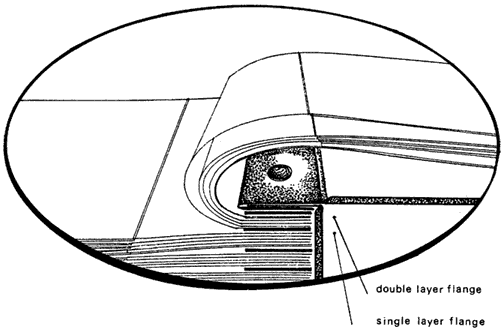Modifications of a Basic Polyester Post Binding
by Barbara Meier-JamesThe polyester post binding was developed as a serviceable structure for housing multiple polyester-encapsulated leaves. In many instances, this structure offers the only solution to the problem of preserving fragile or brittle material without having to change irreversibly its appearance or format. It also offers a solution to the problem of making material available for reader use, which would otherwise require labor-intensive treatment. In some cases, time restraints or value limitations make such lengthy treatments inappropriate. The polyester post binding, therefore, is a functional alternative. As originally developed, however, it has certain inherent structural and aesthetic limitations. The challenge then is to overcome these limitations.
Polyester bindings were originally tape sealed encapsulations with binding flanges drilled through and these flanges secured with metal screw posts between the cover boards—hence the name post binding. Initially the binding flange was an extension of the two layers of film which made up the encapsulation. Later this flange was modified to a single thickness of polyester. Groups of flanges were interspersed with filler strips to compensate for the added bulk of the encapsulated material. There were some problems with this structure. The tape-sealed encapsulations increased the overall dimensions by the width of the tape and visually detracted from the material. In addition the visible screw attachment suggested easy dismantling of the volume and perhaps theft of the individual leaves. The screws were also visually distracting. The narrow binding flange tended to inhibit the turning of the leaves, especially in volumes thicker than one and a quarter inches. The narrow flange also hampered the opening in cases where the encapsulated material was resistant to flexing due to sheet thickness, rigidity, or pronounced cockling throughout the text impression. Finally, the static charge generated by the polyester film made dust accumulation a problem.
Modifications can be made to alleviate these problems. The sonic welding machine, developed by Bill Minter, eliminates the use of the unsightly tape by sealing the polyester film with a thin weld which is flexible and makes possible a format more closely approximating the size of the original material. The weld allows greater flexibility of the encapsulation and avoids the problems of material shifting within, and coming in contact with the double-sided tape. Covering the post heads camouflages the screw attachment, and improves the look of the binding when opened. Finally, problems relating to the turning of the leaves can be eliminated by the use of a wider binding flange and the use of more and thinner spacer strips. Slipcases can provide the necessary protection for polyester bindings and thereby reduce dust accumulation.
This modified post binding structure was used for a two volume set of Arabic grammar that was required for research purposes. The volumes were so badly worm eaten, oversewn, and heavily glued up that they were impossible to open, much less handle, without incurring further damage. Treatment options were limited because the time required to make the material serviceable was prohibitive. The worm hole tracery was so extensive that the folios had been reduced to single leaves. These problems were compounded by the cockling throughout the leaves, at right angles to the spine, which prevented the leaves from turning easily. Given its current condition and servicing requirements, it was decided to prepare this material in a polyester binding.
The single leaves were encapsulated using the ultrasonic welder and the width of the flange increased to accommodate the flexing problems. To improve the appearance of the encapsulated material, care was taken to maintain page alignment within the encapsulation thereby allowing areas of loss to be viewed in their original configuration. The single thickness flange was alternated with a double layer every ten leaves and a visually compatible paper was inserted within this flange. This use of the paper insert cut down on the reflective quality of the polyester film. The single flange gave greater flexibility and the periodic use of the double layer with paper insert reduced the tendency of the single layer to sag as a result of the increased width of the flange.
The post heads were covered to eliminate their distracting metallic shine. This was accomplished by punching discs of the covering cloth and affixing these to the roughened screw surface with contact cement. In a pinch, double-sided tape could be used instead of adhesive. The screws pass through the folded cover flange, the corresponding spine piece flange and between these the binding flanges of the encapsulated material with spacer cards interspersed between them. These spacer strips were thinner and interspersed more frequently between the flanges. They were covered with the same paper used for the flange insert. The use of more thin spacers reduced the tendency of the bunching which occurs when groups of many flanges are held between fewer thicker spacers. The wider flange, approximately 1 1/2 times the width of the spacer strips allowed for the full movement of the encapsulated leaves. Each leaf was able to move up and around the preceding leaves without any flexing of the area of the encapsulation. This was particularly important in this case, because the amount of worm tunneling throughout the text made it extremely vulnerable to crimping when the leaves were turned. Finally, to reduce exposure to dust which polyester so readily attracts, slipcases were constructed for each volume.
In conclusion, the polyester post binding is a useful structure. The challenge is to modify the basic construction to produce a binding structure which is visually satisfying and functionally appropriate to the specific requirements of the encapsulated material.
Polyester Post Binding
Barbara Meier-JamesRare Book Conservator
Conservation Office
